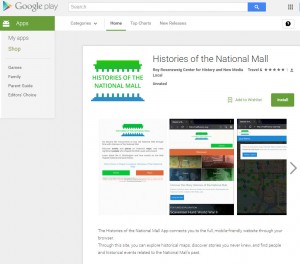
Some smart phone owners look for native applications (apps) first when preparing to travel. To attract users searching for apps first, we decided to create an app placeholder that makes Histories of the National Mall visible in an app store. A project associate used a cross-platform service to wrap the content and design of mallhistory.org into a single-page launchpad to the site and released it as an app for Android users.
We chose Apache Cordova to create an app for different mobile operating systems. Rather than building a separate app with its unique software development kit, Cordova streamlines the process. A major advantage to building with Cordova is that a developer does not need to learn many coding languages (C+, Cocoa, or Java) to produce apps for different platforms. Developing once through a cross-platform system like Cordova saves any team time and resources.
Since we never intended to package the entire site as an app, we created a simple redirection page using HTML and CSS that prompts the user to visit the full site using their web browser. The Histories of the National Mall “app” is really a placeholder and means for publicizing the project to users browsing in app stores.
The process of creating the placeholder app was relatively straightforward. (Read more in the next section how to build with Cordova). Submitting and releasing an app, however, was a bigger challenge than we anticipated. Each store requires that the person or organization submitting the app create a developer account. We wanted the Roy Rosenzweig Center for History and New Media to be the organization, rather than any individual developer, because RRCHNM will be responsible for the long-term maintenance of the “app.” This was possible in the Android store, but not for Apple, and as a result, our placeholder app was never accepted or available in the Apple store.
The problem we faced is unique to our organization. Apple requires that organizations submit tax ID numbers to verify that an organization is legitimate. RRCHNM is a separate entity within George Mason University, but does not have a unique tax ID number. Mason has an institutional Apple developer ID, but we wanted to maintain control over its status and maintenance. Individual staff members considered obtaining a developer account, but then she or he needed to submit personal credit card information to pay the annual developer fee, and her or his name would appear as the developer. That person would then be responsible for maintaining the license for the project, even if she or he left RRCHNM. RRCHNM needed to be listed as the developing organization, and so we could only make a placeholder app in the Google Play/Android store.